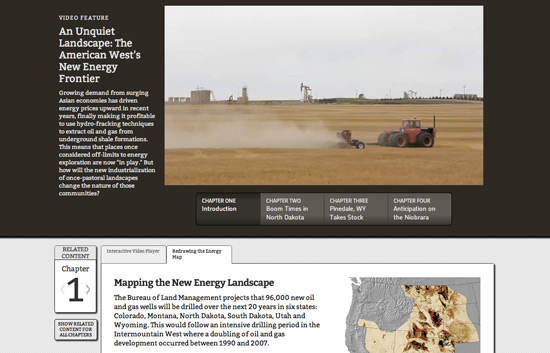Dedicated to advancing scholarly and public understanding of the past, present, and future of western North America, the Center supports research, teaching, and reporting about western land and life in the United States, Canada, and Mexico.
Gone Fishin'
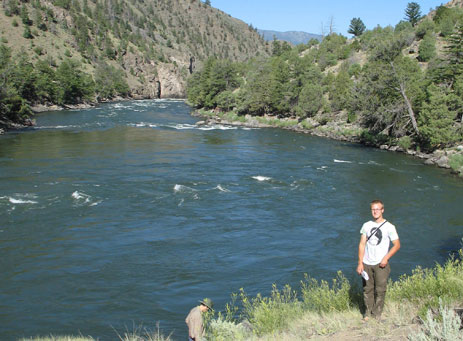
By Daniel Perret
B.A. in Biology, 2013
Read about our summer interns on the OutWest student blog. Throughout the summer, the Center's interns will be sending in virtual postcards, snapshots and reports on their summer work.
 Yellowstone National Park is an international destination for people who love to fish, from casual stick-and-string dock anglers to hardcore wader-wearing fly-fishers. For thousands of years, people have utilized the bountiful piscine resources of the many creeks, lakes, and rivers that pepper the Yellowstone countryside.
Yellowstone National Park is an international destination for people who love to fish, from casual stick-and-string dock anglers to hardcore wader-wearing fly-fishers. For thousands of years, people have utilized the bountiful piscine resources of the many creeks, lakes, and rivers that pepper the Yellowstone countryside.
Hang on a second! Until very recently, no evidence of prehistoric (defined as pre-1750) fishing activity has ever been found within the park. Theories abounded as to the reason. Maybe the prehistoric Native American residents of the park held a cultural taboo against fish consumption? Did they simply lack the technology to exploit the resource? Or have our best archaeological efforts simply missed the traces?
In 2006, an excavation at an important new site near the northern park boundary proved the third option correct. The excavation team found two net-sinker weights, one on each side of the Yellowstone River. The net-sinkers are heavy, impressive affairs; large, ovate river cobbles with considerable notches worked into opposite sides. Subsequent excavations of the site reached a depth of four meters, where Paleo-Indian knives were recovered, indicating that the site had been occupied as early as 10,500 years before present (YBP). Although the net-sinkers themselves probably date to the late pre-historic period (3,000 YBP – 300 YBP), they represented the first evidence of fishing ever recovered in Yellowstone.
Fast forward six years. Two park archaeologists and I are back at this important area, performing a site condition assessment. We walk transects, eyes on the ground, on the prowl for lithic artifacts and possible threats to the site. I spot a large rock that looks suspiciously out of place, eroding out of the riverbank. I pick it up, dust it off, and see that this is no ordinary rock. Another net-sinker, and the third ever recovered!
Hunting with Fire May Benefit Australia's Small Mammals

Photo: Rebecca Bliege Bird
When species start disappearing, it usually makes sense to blame it on the arrival of humans. But in the case of Western Australia's declining small-mammal populations, the opposite may be true.
The Aboriginal Martu people of Western Australia have traditionally set small fires while foraging, leaving a patchwork landscape that proves a perfect environment for bilbies, wallabies, possums and other threatened mammals.
Stanford anthropologists have discovered that when these controlled burns cease, the desert rapidly becomes overgrown – and a single lightning strike can send wildfires tearing through hundreds of square miles of tinder-dry mammal habitat.
The paper, authored by Stanford anthropology Associate Professor Rebecca Bliege Bird, senior research scientist Douglas Bird, postdoctoral scholar Brian Codding, and undergraduate Peter Kauhanen, appeared recently in the journal Proceedings of the National Academy of Sciences.
Douglas Bird and Brian Codding coordinate the Comparative Wests project at the Bill Lane Center for the American West.
Madeline Weeks Joins the Center as Program and Research Associate
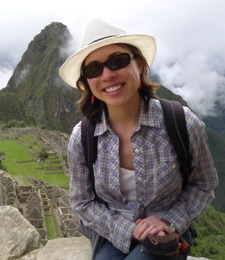 We are excited to welcome a new staff member to the Bill Lane Center for the American West. Madeline Weeks is our new Program and Research Associate. She will run our summer internship program, coordinate our undergraduate research assistants, help organize events, and pursue her own independent research at the Center.
We are excited to welcome a new staff member to the Bill Lane Center for the American West. Madeline Weeks is our new Program and Research Associate. She will run our summer internship program, coordinate our undergraduate research assistants, help organize events, and pursue her own independent research at the Center.
A native of Northern California, Madeline joins us after working at Morningstar Investments in Chicago. She is a 2011 graduate of Wellesley College, where she double-majored in Spanish and Economics, and wrote a senior thesis on the role of chocolate in Mexican history, religion, and culture. She also studied abroad in China, Spain, and Mexico, and spent internships at the Economist Magazine and the Institute of International Eductation.
This September, Madeline will head into the field and coordinate our Sophomore College course in Idaho, "People, Land, and Water in the Heart of the West," co-taught by Professors David M. Kennedy and David Freyberg. Over the summer she will edit posts from our interns throughout the West on our "Out West" blog. Her own research will focus on the California wine industry.
Madeline takes the reins from Heather West, who left the Center in June and will begin graduate studies this fall in environmental science and business administration at Yale University.
Please join us in welcoming Madeline to the team, and feel free to drop by and say "howdy" at our new offices on the first floor of the Jerry Yang and Akiko Yamazaki Environment and Energy Building (Y2E2), room 174. Madeline is also reachable at [email protected].
Envisioning California's Delta As It Was
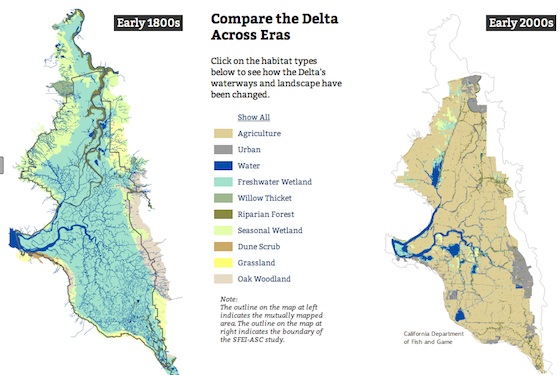
California's Sacramento-San Joaquin Delta has been transformed from a teeming wetland to valuable farmland, cities and towns, and a vast network of reservoirs and canals carrying a great part of the state's water supply from where it originates to where it is needed. With the Delta's ecosystem in crisis and difficult policy decisions looming, the Bill Lane Center for the American West has co-produced an innovative interactive exploration of the historical Delta in collaboration with KQED Public Media and the San Francisco Estuary Institute-Aquatic Science Center.
"Envisioning California's Delta As it Was" is an online companion to a series of radio reports by reporter Lauren Sommer on KQED's science and environment program, QUEST. Using more than 20 pages of interactive maps, charts and archival imagery, the feature guides readers through the wealth of historical clues that researchers at SFEI's Aquatic Science Center used to envision what the Delta was like before the Gold Rush, the creation of the rich farmlands, the State Water Project., and other major developments. SFEI's research, led by Alison Whipple, a former intern at the Bill Lane Center for the American West, is culminating in a major report on the historical ecology of the Delta, due out in June.
This spring, QUEST reporter Lauren Sommer was a media fellow at the Bill Lane Center for the American West and worked extensively with SFEI and the Center's creative director of media and communication, Geoff McGhee, to mine the wealth of research materials to create a radio documentary and interactive guide to the report.
The interactive feature is available at QUEST's website. A radio documentary on the historical detective work behind the report "Can We Bring Back What We've Lost?" airs Monday morning, May 14 on KQED and California public radio stations, and can be heard online at KQED.org.
Mapping Texts: Visualizing Historical American Newspapers
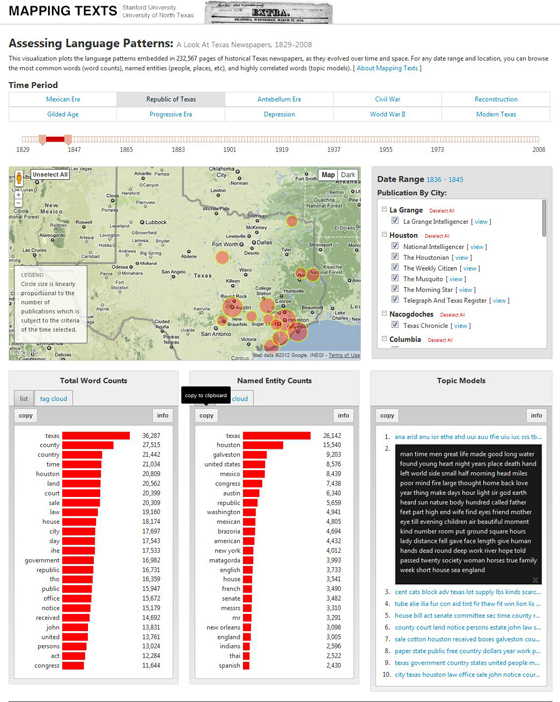
The Mapping Texts project, a collaboration between the University of North Texas and the Bill Lane Center for the American West at Stanford University, has just released two stunning new interactive visualizations that allow users to map language patterns embedded in 230,000 pages of digitized historical newspapers from the late 1820s through the early 2000s.
Sponsored by a Digital Humanities Start-Up Grant from the National Endowment for the Humanities, the project team—led by Andrew J. Torget from UNT and Jon Christensen from Stanford—spent the last eighteen months experimenting with developing new methods for finding and analyzing patterns embedded in massive collections of historical newspapers.
"One thing I find particularly compelling about this project," says Brett Bobley, chief information officer at the NEH and director of the NEH Office of Digital Humanities, "is that since all the National Digital Newspaper Project pages are created using the same standards, work like the Mapping Texts project could, in theory, scale beyond the Texas newspapers to other states or even nationally. As we scan millions of pages of newspapers (and other humanities materials) new methods for searching and analyzing the materials will become critical to scholarship."
The primary goal of the Mapping Texts project, explains Torget, “was to find new ways for people to make sense of the overwhelming abundance of information being made available in the digital age. Historical newspapers are being digitized at an astonishing rate. The Chronicling America project, for example, now provides access to over four million pages. People are going to need new ways to make sense of such massive and rich collections, because when you can explore hundreds of millions of words a basic text search simply isn’t enough.”
The project focused on a collection of historical Texas newspapers digitized by the University of North Texas Library as part of Chronicling America’s National Digital Newspaper Program. Together, the UNT and Stanford teams experimented with ways to combine text-mining (to find patterns in the collection) and data visualization (to make sense of them) in order to produce new visual indexes of the newspapers.
“By mapping the contents of these newspapers across both time and space, as well as the quality of the OCR digitization,” says Christensen, “we aimed not just to reveal patterns and surprises in the collection that you simply would not otherwise see, but also to give researchers a concrete sense of what information is and what information is not available to them in a large digital archive.”
The results are two interactive visualizations:
(1) “Mapping Newspaper Quality” maps a quantitative survey of the newspapers, plotting both the quantity and quality of information available in the digitized collection. Through graphs, timelines, and a regional map, users can explore the quantity of information available for any particular time period, location, or newspaper, as well as the quality of the digitization of the newspapers. By clicking on individual newspaper titles, users can also access the original newspaper pages.
(2) “Mapping Language Patterns” maps a qualitative survey of the newspapers, plotting major language patterns embedded in the collection. For any given time period, geography, or newspaper title, users can explore the most common words (word counts), named entities (people, places, etc), and highly correlated words (topic models), which together provide a window into the major language patterns emanating from the newspapers. Users can also click on individual newspaper titles to access the original documents.
For more on the project, including the project's technical white paper and links to the visualizations, please visit: https://mappingtexts.org/.
Are Western Communities Getting a Fair Return on Energy Development?
With sky-high energy prices driving new oil and gas exploration in the American West, states are struggling to keep pace with critical infrastructure and revenue policies. Western North Dakota, for example, is in the throes of a raging energy boom, as hydraulic fracking and horizontal drilling techniques coax valuable hydrocarbons out of long-dormant oilfields. But as towns like Williston see their populations double virtually overnight and vital farm-to-market roads crumble under 18-wheel trucks, how best to ensure that local communities can survive the onslaught, and to reap rewards that benefit the whole state, long after the boom is over?
Working with Montana-based Headwaters Economics, The Center's Rural West Initiative has published a comprehensive multimedia report online, combining a rigorous economic and policy analysis with a 31-minute interactive video documentary called "An Unquiet Landscape: The American West's New Energy Frontier."
The video feature, reported by the intiative's director, John McChesney, looks at three rural western communities at different stages of the process of energy development: North Dakota, where a recent drilling frenzy has pushed it to the third-highest oil production in the U.S.; western Wyoming, where residents are coping with air pollution and habitat destruction after a decade of oil and gas exploration; and eastern Wyoming, where residents of one of the state's poorest communities pin their hopes on a boom on the local Niobrara formation.
"Energy development is arguably the greatest force transforming the rural West today," says McChesney, who came to direct the Bill Lane Center for the American West's Rural West Initiative after three decades at NPR.
The video report is published in an innovative format, an annotated, interactive player that presents supplementary information at key points in the documentary. "The player combines the benefits of powerful video storytelling with the precision of print and the linked nature of the web," says Geoff McGhee, the Center's Creative Director, who was a co-producer of the video. The team will be sharing the source code for the interactive player under an open source, creative commons license for noncommercial reuse.
The Headwaters report can be downloaded in its entirety from the Rural West Initiative website.
Generation Anthropocene

History is accelerating. Global population has crossed seven billion, the planet’s temperature continues its abrupt rise, and scientists warn we are in the midst of a new mass extinction. Transformations this enormous are rare in earth’s 4.6 billion year history and humankind’s planetary impact is geologic in scale. We have caused a new geologic age, and it has a name: the Anthropocene. Our students have grown up in this new era, and they are keen on learning what it will mean to live in the Anthropocene.
This spring graduate students Mike Osborne and Miles Traer, along with journalist and lecturer Thomas Hayden, taught a course for undergraduates entitled "Podcasting the Anthropocene." Their project: to have students learn about and communicate the gravity of these transformations and the evolving perceptions of environmentalism, sustainability, and science. Students spoke with geologists, engineers, ecologists, doctors, project managers, oceanographers, and historians on a wide variety of topics ranging from biodiversity loss to historical perceptions of the environment to agricultural systems to urban design to conservation philosophy.
The concept was to elicit the expertise of the Stanford community by having students sit down for one-on-one interviews with these researchers — including Richard White, faculty co-director of the Bill Lane Center for the American West, Jon Christensen, the Center's executive director, and Doug Bird, anthropologist and director of our Comparative Wests project — to explore their careers, their perspectives, and their understanding of the Anthropocene.
Click here to learn more about "Generation Anthropocene" and listen to the interviews.
Richard White's History of Transcontintental Railroads Wins Los Angeles Times Book Prize and Is a Pulitzer Prize Finalist
American history professor Richard White‘s book, Railroaded: The Transcontinentals and the Making of Modern America, won the 2011 Los Angeles Times Book Prize in history in late April, and earned a finalist spot in the 2012 Pulitzer Prize history category.
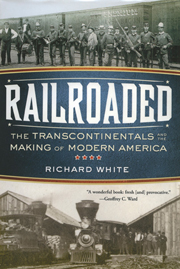 The Pulitzer selection committee is comprised of esteemed historians and White said although he didn’t win the Pulitzer, it was a “great honor” to be recognized by his peers.
The Pulitzer selection committee is comprised of esteemed historians and White said although he didn’t win the Pulitzer, it was a “great honor” to be recognized by his peers.
Twelve years ago, White began to investigate how the creation of the railroad system affected the development of the American West. Along the way, he uncovered tales of political intrigue, bribery and outright scandal that resonated with readers when his book was published in 2011.
“The financial crisis and scandals of the last few years were terrible for the country, but good for the book,” said White, who also is faculty co-director of the Bill Lane Center for the American West.
White’s findings go beyond the traditional accounts of the railroads as the first modern corporations. His research reveals “how closely intertwined the railroads were with the political system” and demonstrates how they were “as much creatures of commerce as creatures of politics.”
White is no stranger to the Pulitzer process. In 1992, his book, The Middle Ground: Indians, Empires, and Republics in the Great Lakes Region, 1650-1815, was a Pulitzer Prize nominated finalist. He has also been on the selection committee.
White is currently working on a history of the American “Gilded Age” from 1865 to 1896, which will be published as part of the Oxford History of the United States series.
A Decade of Fire in Western Australia: Comparing Aboriginal Fire Regimes to Lightning Fire Regimes
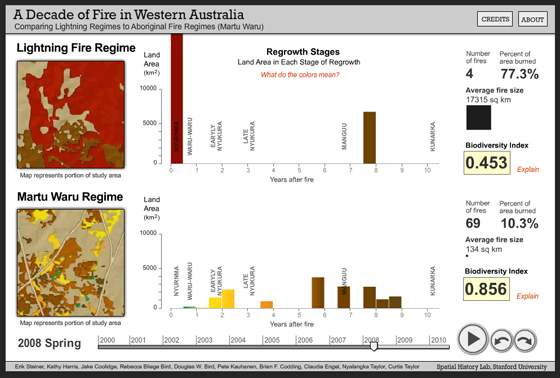
The Spatial History Project at Stanford has published an interactive online visualization of a decade of fire in western Australia based on the work of researchers in our Comparative Wests project at the Bill Lane Center for the American West. The visualization is based on a combination of ethnographic and ecological research undertaken by Stanford faculty and students in collaboration with indigenous Martu and was originally developed as a touchscreen application for the art exhibit Waru! Holding Fire in Australia’s Western Desert at the Thomas Welton Stanford Gallery in Summer 2011.
Ethnographic field work included interviews with Martu and quantitative observations of Martu hunting and burning. Ecological research included on the ground monitoring of areas at different stages of regrowth following a fire and spatial analysis of satellite imagery to classify burns over a ten year period from 2000-2010.
In the arid spinifex grasslands of Western Australia, fires are an integral part of the ecology. Following the first rains after a fire, small shoots of green vegetation begin to grow out of the newly enhanced sand. About a year later, the area will be dominated by fruiting and herbaceous plants, many of which are important sources of food for Aboriginal people. By about five years following the fire, spinifex grass begins to dominate once again. A large hummock grass, spinifex reaches out from its center and begins to crowd out all of the other plants. Eventually spinifex comes to dominate the entire sand plain and the process can begin again with another fire.
Martu fires, lit most frequently in the context of sand monitor lizard hunting, are significantly smaller than lightning ignition fires. Over time, these differences build into different contrasting landscapes. Within the Martu region, the visualization shows the fine-grained mosaic of different aged vegetation patches created by the Aboriginal fire regime over time. In contrast, the lightning regime is dominated by a small number of extremely large fires. The end result is a much more heterogeneous and diverse landscape within the area dominated by Aboriginal fires. This diversity also benefits other desert species.


